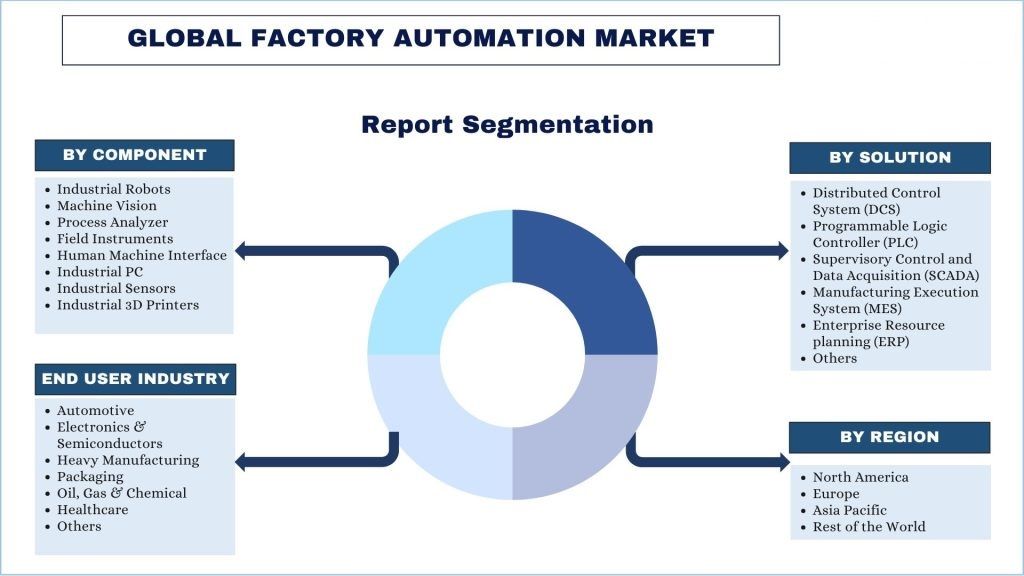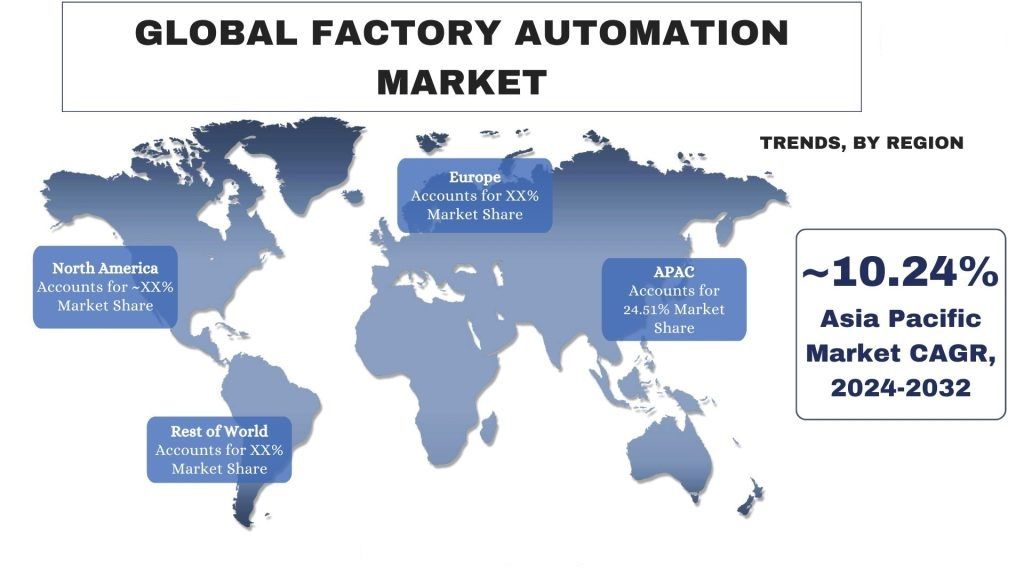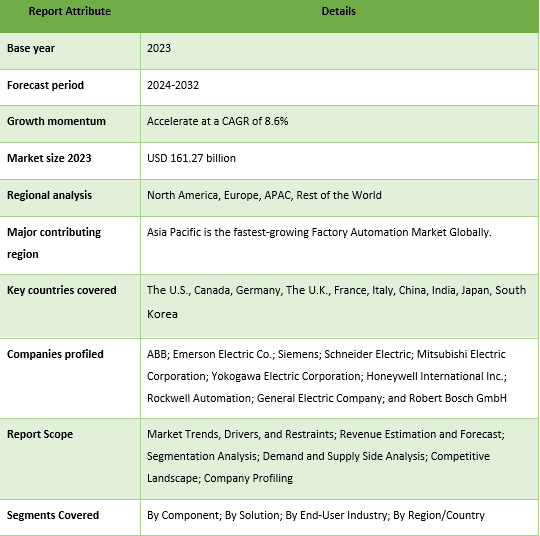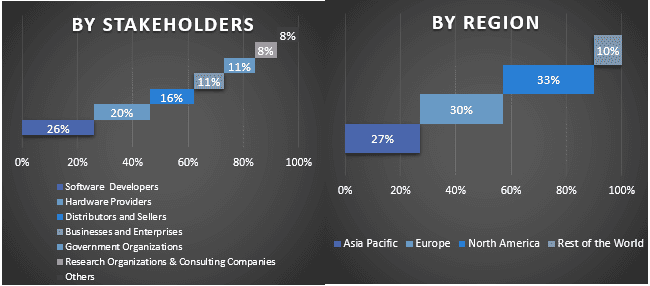- Home
- About Us
- Industry
- Services
- Reading
- Contact Us
Factory Automation Market: Current Analysis and Forecast (2024-2032)
Emphasis on Component (Industrial Robots, Machine Vision, Process Analyzers, Field Instruments, Human-Machine Interfaces, Industrial Pcs, Industrial Sensors, and Industrial 3D Printers); Solution (Distributed Control System (DCS), Programmable Logic Controller (PLC), Supervisory Control and Data Acquisition (SCADA), Manufacturing Execution System (MES), Enterprise Resource Planning (ERP), and Others); End-User Industry (Automotive, Electronics & Semiconductor, Heavy Manufacturing, Packaging, Oil, Gas, & Chemical, Healthcare, and Others); and Region/Country

Factory Automation Market Size & Forecast
The Global Factory Automation market was valued at USD 161.2 billion and is expected to grow at a strong CAGR of around 8.6% during the forecast period (2024-2032) owing to the growing need for boosting production and operational efficiency, aimed at minimizing the cost while maintaining the quality.
Factory Automation Market Analysis
Factory automation refers to the use of control systems, machinery, and technologies to streamline manufacturing processes, reducing the need for human intervention while optimizing production efficiency. It involves the automation of tasks traditionally performed by humans, using machines, actuators, sensors, processors, and networks to automate production processes. The history of factory automation started with basic mechanisms like conveyor belts in assembly lines, evolving to advanced robotic systems and computerized control.
Factory automation, the integration of advanced technologies into manufacturing processes, is witnessing a remarkable surge across various industries. This transformative shift is being driven by a multitude of factors that are reshaping the way factories operate. From enhancing efficiency and productivity to addressing labor shortages and improving product quality, factory automation is emerging as a game-changer in the manufacturing landscape. Furthermore, manufacturers are under constant pressure to optimize their operations and maximize output while minimizing costs in today’s highly competitive global market. Automated systems can operate around the clock with minimal downtime, resulting in higher production rates and improved overall equipment effectiveness (OEE). For instance, according to a report by the International Federation of Robotics (IFR), the implementation of industrial robots has led to an average increase in productivity of 15-30% in various industries. Additionally, many industries, particularly in developed economies, face a shortage of skilled labor due to an aging workforce and shifting demographic trends. Automation technologies can alleviate this challenge by taking over repetitive, physically demanding, or hazardous tasks, reducing the reliance on human labor. According to estimates, labor costs account for up to 25% of total manufacturing costs in developed countries, driving the adoption of automation to remain competitive. Moreover, automated systems are highly precise and consistent, reducing the risk of human error and ensuring consistent product quality. Industries such as automotive, electronics, and pharmaceuticals, where quality control is critical, are increasingly adopting automation to meet stringent quality standards. For instance, according to a survey by the Association for Manufacturing Technology (AMT), 70% of manufacturers cited improved product quality as a key driver for implementing automation solutions. Lastly, the Industry 4.0 revolution, which promotes the digitization and interconnectivity of manufacturing processes, has accelerated the adoption of automation technologies. Smart factories, enabled by IoT, cyber-physical systems, and cloud computing, leverage automation to achieve real-time monitoring, data-driven decision-making, and flexible production capabilities.

Factory Automation Market Trends
This section discusses the key market trends that are influencing the various segments of the Factory Automation Market as identified by our team of research experts.
Industrial robots have firmly established themselves as the backbone of the factory automation industry worldwide.
Industrial robots are the most widely adopted and are in high demand. Industrial robots have firmly established themselves as the backbone of modern factory automation. These highly versatile machines can perform various tasks with unparalleled precision, speed, and consistency. From assembly and welding to material handling and packaging, industrial robots have become indispensable assets across various industries, including automotive, electronics, and consumer goods. The dominance of industrial robots can be attributed to their potential to increase productivity and efficiency. Industrial robots aid in improving productivity while lowering costs and generating high-quality goods in automation applications. Furthermore, technological advancements have played a significant role in the adoption of industrial robots. The development of 5G wireless technology and the adoption of Industry 4.0 have driven the demand for factory automation solutions. The Industrial Internet of Things (IIoT) is essential to automation technology as it facilitates the development of efficient, cost-efficient, and responsive system architectures. Factors such as these foster a conducive environment and support the growth in adopting industrial robots for factory automation across various industries.
Asia Pacific Emerges as the Fastest Growing Market for Factory Automation Worldwide.
Within the Asia Pacific, countries such as China, India, South Korea, Japan, and India have established themselves as frontrunners in adopting factory automation to achieve a competitive edge in the global markets.
Asia Pacific is anticipated to experience substantial growth during the predicted timeframe, where countries like China, Japan, Taiwan, South Korea, and India are rapidly emerging as a dominant force in the factory automation market. Primarily driven by the surging industrialization of the region. The Asia Pacific region is experiencing a surge in industrialization, driven by the growing demand for consumer goods and the increasing presence of multinational corporations. This trend has fueled the need for efficient and automated manufacturing processes, propelling the adoption of factory automation solutions. Furthermore, several countries in the Asia Pacific region, such as Japan and China, are facing labor shortages due to aging populations simultaneously with the challenges of rising labor costs. Factory automation counters both these challenges by reducing the reliance on manual labor and increasing operational efficiency. Moreover, embracing factory automation is enabling manufacturers in the Asia Pacific region to gain a competitive edge in the global market. Automated processes enable them to produce high-quality products at lower costs, making their offerings more attractive to consumers worldwide. Factors such as these have created a scenario that has led to the high growth of factory automation in the Asia Pacific region.

Factory Automation Industry Overview
The factory automation market is competitive and fragmented, with the presence of several global and international market players. The key players are adopting different growth strategies to enhance their market presence, such as partnerships, agreements, collaborations, new product launches, geographical expansions, and mergers and acquisitions. Some of the major players operating in the market are ABB; Emerson Electric Co.; Siemens; Schneider Electric; Mitsubishi Electric Corporation; Yokogawa Electric Corporation; Honeywell International Inc.; Rockwell Automation; General Electric Company; and Robert Bosch GmbH.
Factory Automation Market News
- On April 24, 2024, Muller Technology announced plans to introduce custom mobile robotic systems at the NPE 2024 exhibition from May 6-10. These solutions aim to address the labor shortage in the U.S. plastics processing industry while improving versatility, flexibility, efficiency, and productivity. Muller’s new offerings include Autonomous Mobile Robots (AMRs) and Mobile Manipulators (MoMas), which have been proven to boost productivity and reduce OSHA recordable incidents.
- In September 2023, during the 2023 China International Industry Fair (CIIF), ABB introduced a comprehensive selection of cutting-edge robotics automation offerings, solutions, software, and services at its 800m2 exhibition space. This included the debut of two new products: OptiFact™, ABB’s initial modular software platform, and the new IRB 1090 industrial educational robot.
Factory Automation Market Report Coverage

Factory Automation Market Report Coverage Reasons to buy this report:
- The study includes market sizing and forecasting analysis validated by authenticated key industry experts.
- The report presents a quick review of overall industry performance at one glance.
- The report covers an in-depth analysis of prominent industry peers with a primary focus on key business financials, product portfolios, expansion strategies, and recent developments.
- Detailed examination of drivers, restraints, key trends, and opportunities prevailing in the industry.
- The study comprehensively covers the market across different segments.
- Deep dive regional level analysis of the industry.
Customization Options:
The Global Factory Automation market can further be customized as per the requirement or any other market segment. Besides this, UMI understands that you may have your own business needs; hence, feel free to contact us to get a report that completely suits your requirements.
Table of Content
Research Methodology for the Factory Automation Market Analysis (2024-2032)
Analyzing the historical market, estimating the current market, and forecasting the future market of the global Factory Automation market were the three major steps undertaken to create and analyze the adoption of Factory Automations in major regions globally. Exhaustive secondary research was conducted to collect the historical market numbers and estimate the current market size. Secondly, to validate these insights, numerous findings and assumptions were taken into consideration. Moreover, exhaustive primary interviews were also conducted with industry experts across the value chain of the global Factory Automation market. Post assumption and validation of market numbers through primary interviews, we employed a top-down/bottom-up approach to forecasting the complete market size. Thereafter, market breakdown and data triangulation methods were adopted to estimate and analyze the market size of segments and sub-segments of the industry pertains to. Detailed methodology is explained below:
Analysis of Historical Market Size
Step 1: In-Depth Study of Secondary Sources:
A detailed secondary study was conducted to obtain the historical market size of the Factory Automation market through company internal sources such as annual reports & financial statements, performance presentations, press releases, etc., and external sources including journals, news & articles, government publications, competitor publications, sector reports, third-party database, and other credible publications.
Step 2: Market Segmentation:
After obtaining the historical market size of the Factory Automation market, we conducted a detailed secondary analysis to gather historical market insights and share for different segments & sub-segments for major regions. Major segments are included in the report, such as component, solution, and end-user industry. Further country-level analyses were conducted to evaluate the overall adoption of testing models in that region.
Step 3: Factor Analysis:
After acquiring the historical market size of different segments and sub-segments, we conducted a detailed factor analysis to estimate the current market size of the Factory Automation market. Further, we conducted factor analysis using dependent and independent variables such as component, solution, and end-user industry of the Factory Automation market. A thorough analysis was conducted of demand and supply-side scenarios considering top partnerships, mergers and acquisitions, business expansion, and product launches in the Factory Automation market sector across the globe.
Current Market Size Estimate & Forecast
Current Market Sizing: Based on actionable insights from the above 3 steps, we arrived at the current market size, key players in the global Factory Automation market, and market shares of the segments. All the required percentage shares split, and market breakdowns were determined using the above-mentioned secondary approach and were verified through primary interviews.
Estimation & Forecasting: For market estimation and forecast, weights were assigned to different factors including drivers & trends, restraints, and opportunities available for the stakeholders. After analyzing these factors, relevant forecasting techniques, i.e., the top-down/bottom-up approach, were applied to arrive at the market forecast for 2032 for different segments and sub-segments across the major markets globally. The research methodology adopted to estimate the market size encompasses:
- The industry’s market size, in terms of revenue (USD) and the adoption rate of the Factory Automation market across the major markets domestically
- All percentage shares, splits, and breakdowns of market segments and sub-segments
- Key players in the global Factory Automation market in terms of products offered. Also, the growth strategies adopted by these players to compete in the fast-growing market.

Factory Automation Market Graph
Market Size and Share Validation
Primary Research: In-depth interviews were conducted with the Key Opinion Leaders (KOLs), including Top Level Executives (CXO/VPs, Sales Head, Marketing Head, Operational Head, Regional Head, Country Head, etc.) across major regions. Primary research findings were then summarized, and statistical analysis was performed to prove the stated hypothesis. Inputs from primary research were consolidated with secondary findings, hence turning information into actionable insights.
Split of Primary Participants in Different Regions
Market Engineering
The data triangulation technique was employed to complete the overall market estimation and to arrive at precise statistical numbers for each segment and sub-segment of the global Factory Automation market. Data was split into several segments & sub-segments after studying various parameters and trends in the areas of component, solution, and end-user industry in the Global Factory Automation market.
The main objective of the Global Factory Automation Market Study
The current & future market trends of the global Factory Automation market were pinpointed in the study. Investors can gain strategic insights to base their discretion for investments on the qualitative and quantitative analysis performed in the study. Current and future market trends determined the market’s overall attractiveness at a regional level, providing a platform for the industrial participant to exploit the untapped market to benefit from a first-mover advantage. Other quantitative goals of the studies include:
- Analyze the current and forecast market size of the Factory Automation market in terms of value (USD). Also, analyze the current and forecast market size of different segments and sub-segments.
- Segments in the study include areas of component, solution, and end-user industry.
- Define and analyze the regulatory framework for the Factory Automation
- Analyze the value chain involved with the presence of various intermediaries, along with analyzing customer and competitor behaviors of the industry
- Analyze the current and forecast market size of the Factory Automation market for the major region
- Major countries of regions studied in the report include Asia Pacific, Europe, North America, and the Rest of the World
- Company profiles of the Factory Automation market and the growth strategies adopted by the market players to sustain in the fast-growing market.
- Deep dive regional level analysis of the industry
Frequently Asked Questions FAQs
Q1: What is the current market size and growth potential of the global Factory Automation market?
Q2: What are the driving factors for the growth of the global Factory Automation Market?
Q3: Which segment holds the major portion of the global Factory Automation market by Solution?
Q4: What are the emerging technologies and trends in the global Factory Automation market?
Q5: Which region will be the fastest-growing global Factory Automation market?
Q6: Who are the key players in the global Factory Automation market?
Related Reports
Customers who bought this item also bought










